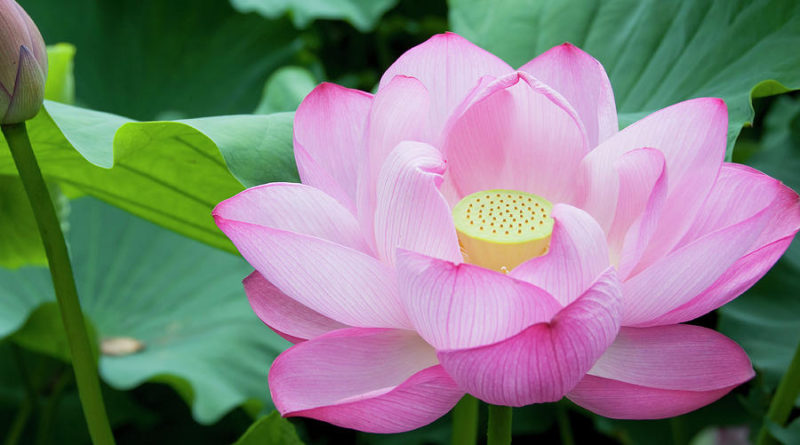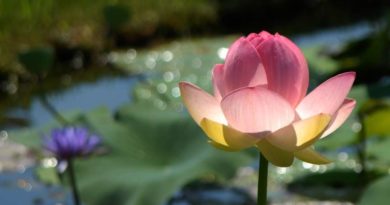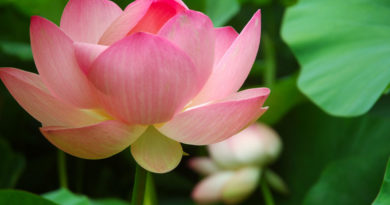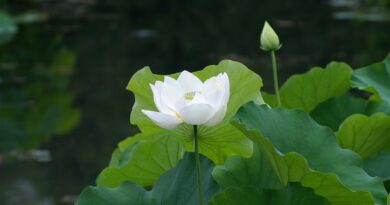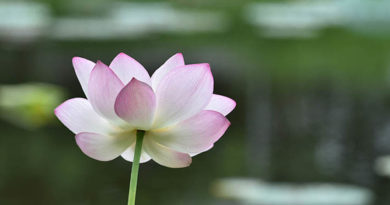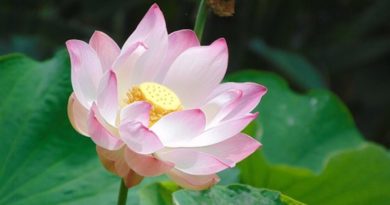ABHIDHAMMA IN DAILY LIFE – CHAPTER 22: JHANACITTAS
The many different kinds of cittas arising in our daily life experience objects through the five sense-doors and through the mind-door. We see, hear, receive impressions through the other doors and think about these objects. Both in the sense-door process and in the mind-door process of cittas there are javana-cittas which are in the case of the non-arahat either kusala cittas or akusala cittas. The javana-cittas are most of the time akusala cittas because we cling to all the objects which are experienced through the sense-doors and through the mind-door. We cling to visible object and seeing, to sound and hearing, to all the objects we experience. We cling to life we want to go on living and receiving sense-impressions. We may not notice when there is clinging after the seeing or hearing, especially when we do not feel particularly glad about what was seen or heard. But there may be lobha-mula-cittas with indifferent feeling. There are likely to be many moments of clinging which pass unnoticed, both in the sense-door processes and in the mind-door processes. Time and again an object is experienced through a sense-door and then through the mind-door and there are also mind-door processes of cittas which think of concepts such as people, animals or things. Clinging to concepts is likely to arise very often and thus we think most of the time with akusala citta. When we do not apply ourselves to dana, sila or bhavana, thinking is done with akusala citta. Even when we perform good deeds there are bound to be akusala cittas shortly after the kusala cittas since there is seeing and hearing time and again and after the seeing or hearing attachment or aversion on account of what we experience may arise. The kusala cittas and akusala cittas, all the cittas which arise in our daily life are of the ‘sensuous plane of consciousness’ or kamavacara cittas.
Cittas which experience sense-impressions are bound up with defilements and therefore wise people, even those who lived before the Buddha’s time, who saw the disadvantages of sense-impressions, developed jhana in order to be temporarily freed from sense-impressions. Jhanacittas are not kamavacara cittas, they are of another plane of consciousness; these cittas experience with absorption a meditation subject through the mind-door. At the moment of jhana one is freed from sense-impressions and from the defilements which are bound up with them. Jhanacittas comprise rupavacara cittas (rupa-jhanacittas) and arupavacara cittas (arupa-jhanacittas). Arupa-jhana is more refined than rupa-jhana, since the meditation subjects of a rupa- jhana are no longer dependent on materiality. Later on I will deal with their differences.
Apart from the planes of citta which are kamavacara cittas, rupavacara cittas and arupavacara cittas, there is still another plane of citta: the lokuttara cittas (translated as supramundane cittas) which have nibbana as their object. Those who attain enlightenment have lokuttara cittas, experiencing nibbana.
As regards jhanacitta, jhanacittas do not have as their object, visible object, sound, or any other sense- impression. Jhanacittas arise in a process of cittas experiencing a meditation subject through the mind-door. In this process there are first kamavacara cittas which experience the meditation subject and then, in that same process, the jhanacitta arises. The process is as follows:
| kamavacara-cittas | mano-dvaravajjana-citta ormind-door-adverting-consciousness parikamma or preparatory consciousness upacara, which means: proximatory or access anuloma or adaptation gotrabhu, which means: that which overcomes the sense-sphere, or ‘change of lineage’ |
| jhana-citta | appana or absorption (the moment of cittawhich attains jhana) |
For some, ‘parikamma’ (preparatory consciousness) is not necessary, and in this case there are, after the mind-door-adverting-consciousness, only three kamavacara cittas arising, instead of four, before the jhanacitta arises. Gotrabhu (which ‘overcomes’ the sense-sphere) is the last citta in that process which is kamavacara citta.
In the ‘Visuddhimagga’ (IV, 74) we can read about the process of cittas in which jhana occurs for the first time. The ‘Visuddhimagga’ (IV, 78) states that only one single moment of jhanacitta arises, which is then succeeded by the bhavanga-citta (life-continuum). After that there is a process of kamavacara cittas, reviewing, through the mind-door, the jhana which has just occurred. Further on (IV, 123 ff. ) we read that absorption can ‘last’ only when it is absolutely purified of states which obstruct concentration. One must first completely suppress lust by reviewing the dangers of sense desires and also suppress the other ‘hindrances’.
Jhanacittas are kusala kamma of a high degree. When jhana has been attained the hindrances of sensuous desire, ill-will, sloth and torpor, restlessness and worry, and doubt are temporarily eliminated. Thus one is truly calm, at least at that moment.
As we have seen in the preceding chapter, the person who wants to cultivate samatha so as to be able to attain jhana, has to develop the five jhana-factors, which can inhibit the hindrances, namely: applied thinking (vitakka), sustained thinking (vicara), rapture (piti), happy feeling (sukha), concentration (samadhi).
Jhana is developed in stages, with each succeeding stage being more refined than the preceding one. There are five stages of rupa-jhana in all. For the first stage of rupa-jhana it is still necessary that all five jhana- factors arise with the jhanacitta, but at each higher stage, when one has become more advanced, jhana- factors are successively abandoned. When one attains to the rupa-jhana of the second stage, one does not need the jhana-factor which is ‘applied thinking’ (vitakka). At this point the jhanacitta can experience the meditation subject without vitakka (which has the characteristic of directing the mind unto an object and the function of ‘touching’ the object). The other jhana-factors still arise with the jhanacitta of the second stage.
At the third stage of jhana ‘sustained thinking’ (vicara) is abandoned. At this stage one does not need vitakka or vicara any longer in order to become absorbed in the meditation subject. Now there are three factors remaining: rapture (piti), happy feeling (sukha) and concentration (samadhi). At the fourth stage rapture (piti) is abandoned. There is still happy feeling accompanying the jhana-citta, but piti does not arise. Without piti, the jhanacitta is more quiet, more refined. At the fifth stage happy feeling (sukha) too is abandoned and there is neutral feeling (upekkha vedana) accompanying the jhanacitta instead of happy feeling. At this stage one is no longer attached to happy feeling. The jhana-factor which is concentration (samadhi) remains.
Some people can, at the second stage of jhana, abandon both ‘applied thinking’ and ‘sustained thinking’ (vitakka and vicara). Consequently, they can, in the third stage, abandon rapture (piti) and in the fourth stage happy feeling (sukha). Thus for them there are only four stages of jhana instead of five. That is the reason why rupa-jhanas can be counted as four stages or as five stages (the fourfold system or the fivefold system). When we read in the suttas about four stages of jhana, the fourfold system is referred to.
There can be up to five stages of rupa-jhana in all and thus there are five types of rupavacara kusala cittas (rupa-jhana kusala cittas). Jhanacitta is kusala kamma of a high degree and thus its result is kusala vipaka of a high degree. Jhanacittas do not produce vipaka in the same lifespan: their result is rebirth in higher planes of existence: rebirth in rupa-brahma planes. If rupavacara kusala citta is to produce the next rebirth, there are rupavacara kusala cittas arising shortly before the dying-consciousness. The patisandhi-citta of the next life is rupavacara vipakacitta which arises in the appropriate rupa-brahma plane. It experiences the same meditation subject as the rupavacara kusala cittas arising shortly before the dying-consciousness of the preceding life. The five types of rupavacara kusala cittas produce five types of rupavacara vipakacittas.
Rupavacara vipakacitta can only perform the function of patisandhi, bhavanga and cuti.
There are five types of rupavacara kiriyacittas which are the cittas of the arahats who attain rupa-jhana. They do not have kusala cittas but kiriyacittas instead. Thus there are fifteen rupavacara cittas in all. Summarizing them, they are:
5 rupavacara kusala cittas
5 rupavacara vipakacittas
5 rupavacara kiriyacittas
Those who have attained to the highest stage of rupa-jhana and see the disadvantages of rupa-jhana which is still dependent on materiality, might want to cultivate arupa-jhana or ‘immaterial jhana’. There are four stages of arupa-jhana. The first stage of arupa-jhana is the ‘Sphere of Boundless Space’ (akasanancayatana). In order to attain this stage of arupa-jhana one has to attain first the highest stage of rupa-jhana in any one of the kasina meditations (The kasina meditations are among the meditation subjects of rupa-jhana. They are, for example, coloured disks or a piece of earth.) excepting the ‘kasina of limited space’ and achieve mastery in it. We read in the ‘Visuddhimagga’ (X, 6):
When he has seen the danger in that [fine-material fourth jhana (The fourth rupa-jhana. Here the counting is according to the ‘fourfold system.’)] in this way and has ended his attachment to it, he gives attention to the ‘Base consisting of Boundless Space’ as peaceful. Then, when he has spread out the kasina to the limit of the world-sphere, or as far as he likes, he removes the kasina (materiality) by giving his attention to the space touched by it, (regarding that) as ‘space’ or ‘boundless space’.
As regards the ‘Sphere of Boundless Space’, the ‘Visuddhimagga’ (X, 6) explains the ‘removing’ of the kasina:
And when the kasina is being removed, it does not roll up or roll away. It is simply that it is called ‘removed’ on account of his non-attention to it, his attention being given to ‘space, space’. This is conceptualized as the mere space left by the removal of the kasina (materiality) …
In this way he can surmount the materiality of the kasina and attain the first arupa-jhana, the Sphere of Boundless Space’. The second stage of arupa-jhana is: the ‘Sphere of Boundless Consciousness’ (vinnanancayatana). The meditation subject of this stage of arupa-jhana is the consciousness which is the first arupa-jhana. The person who wants to attain this stage of arupa-jhana should first achieve ‘mastery’ in the ‘Sphere of Boundless Space’; he should see the disadvantages of this stage and end his attachment to it. We read in the ‘Visuddhimagga’ (X, 25):
…So having ended his attachment to that, he should give his attention to the base consisting of boundless consciousness as peaceful, adverting again and again as ‘Consciousness, consciousness’, to the consciousness that occurred pervading that space (as its object)…
The third stage of arupa-jhana is the ‘Sphere of Nothingness’ (akincannayatana). We read in the ‘Visuddhimagga’ (X, 32) that the person who wants to attain this stage should give his attention to the present non-existence of the past consciousness which pervaded the ‘boundless space’ and which was the object of the second stage of arupa-jhana, the ‘Sphere of Boundless Consciousness’. We read (X, 33):
Without giving further attention to that consciousness, he should (now) advert again and again in this way ‘There is not, there is not’, or ‘Void, void’, or ‘Secluded, secluded’, and give his attention to it, review it, and strike at it with thought and applied thought.
Further on (X, 35) we read:
…he dwells seeing only its non-existence, in other words its departedness when this consciousness has arisen in absorption.
The fourth arupa-jhana is the ‘Sphere of Neither Perception Nor Non-Perception’ (n’eva-sanna-n’asannayatana). The object of this jhana is the third stage of arupa-jhana. We read in the ‘Visuddhimagga’ (X, 49):
The word meaning here is this: that jhana with its associated states neither has perception nor has no perception because of the absence of gross perception and presence of subtle perception, thus it is ‘neither perception nor non-perception’ (n’eva-sanna-n’asannam).
Further on (X, 50) we read:
…Or alternatively: the perception here is neither perception, since it is incapable of performing the decisive function of perception, nor yet non-perception, since it is present in a subtle state as a residual formation, thus it is ‘neither-perception-nor-non-perception’…
It is also explained that the feeling arising with this jhana-citta is ‘neither-feeling-nor-non-feeling’ (since it is present in a subtle state as a residual formation); the same applies to consciousness, contact (phassa) and the other cetasikas arising with the jhanacitta.
Since there are four stages of arupa-jhana, there are four types of arupavacara kusala cittas. They produce vipaka in the form of rebirth in the happy planes of existence which are the arupa-brahma planes. The four types of arupavacara kusala cittas produce four types of arupavacara vipakacittas. Arupavacara vipakacitta can only perform the functions of patisandhi, bhavanga and cuti.
There are four types of arupavacara kiriyacittas which are the cittas of the arahats who attain arupa-jhana. Thus, there are twelve arupavacara cittas in all. Summarizing them, they are:
4 arupavacara kusalacittas
4 arupavacara vipakacittas
4 arupavacara kiriyacittas
Those who have cultivated jhana can develop the various types of ‘direct knowledge’ (abhinna; Also translated as ‘supernormal powers’ or ‘higher intellectual powers’.). They should attain the highest stage of rupa-jhana (the fourth or the fifth, according as to whether they follow the fourfold system or the fivefold system) in the kasina meditations, and they should exercise ‘complete mind-control in fourteen ways’; for example, the attainment of the jhana stages in the different kasina meditations in order and in reverse order. In developing the ‘kinds of direct knowledge’ or ‘supernormal powers’, one’s concentration will become more advanced. The ‘supernormal powers’ (abhinna) are the following:
- Magical powers such as passing through walls, walking on water, travelling through the air.
2. Divine Ear, by which one hears sounds both heavenly and human,far and near.
3. Knowledge of the minds of other people.
4. Divine Eye, by which one sees the deceasing and rebirth of beings.
5. Remembrance of one’s former lives.
These are the five ‘mundane supernormal powers’. However, there is a sixth power, which is a Iokuttara citta, namely, the eradication of all defilements, when arahatship is attained. The sixth power is the greatest and in order to attain it insight has to be fully developed.
Sometimes three kinds of knowledge are mentioned, namely:
- Remembrance of former lives.
2. Heavenly Eye.
3. Destruction of the the Asavas.
Those who have cultivated the right conditions, can achieve ‘marvels’. In the ‘Gradual Sayings’ (Book of the Threes, Ch. VI, par. 60, III, Sangarava) we read about the greatest ‘marvel’. The Budda asked the brahmin Sangarava about the topic of conversation of the royal party, when they were together in the palace. The brahmin Sangarava answered that they were talking about the fact that in former times the monks were fewer in number, but those possessed of supernormal powers were more numerous, and that now it was just the opposite. The Buddha said to him:
‘Now as to that, brahmin, there are these three marvels. What three?
The marvel of more-power, the marvel of thought- reading, the marvel of teaching. And what, brahmin, is the marvel of more-power?
In this case a certain one enjoys sorts of more-power in divers ways. From being one he becomes many, from being many he becomes one; manifest or invisible he goes unhindered through a wall, through a rampart, through a mountain, as if through the air; he plunges into the earth and shoots up again as if in water; he walks upon the water without parting it as if on solid ground; he travels through the air sitting cross-legged, like a bird upon the wing; even this moon and sun, though of such mighty power and majesty,– he handles them and strokes them with his hand; even as far as the Brahma world he has power with his body. This, brahmin, is called ‘the marvel of more-power.’
And what, brahmin, is the marvel of thought-reading? In this case a certain one can declare by means of a sign ‘Thus is your mind. Such and such is your mind. Thus is your consciousness…’
And what, brahmin, is the marvel of teaching? In this case a certain one teaches thus: ‘Reason thus, not thus. Apply your mind thus, not thus. Abandon this state, acquire that state and abide therein.’ This, brahmin, is called ‘the marvel of teaching’. So these are the three marvels. Now of these three marvels, which appeals to you as the more wonderful and excellent?’
‘Of these marvels, master Gotama, the marvel of more-power…seems to me to be of the nature of an illusion. Then again as to the marvel of thought- reading… this also, master Gotama, seems to me of the nature of an illusion. But as to the marvel of teaching… of these three marvels this one appeals to me as the more wonderful and excellent.’
Sangarava then asked the Buddha whether he possessed all three marvels and the Buddha told him that he did. Sangarava also asked whether any other monk possessed them and the Buddha answered:
‘Yes, indeed, brahmin. The monks possessed of these three marvellous powers are not just one or two or three, four, or five hundred, but much more than that in number.’
Sangarava then expressed his confidence in taking refuge in the Buddha, the Dhamma and the Sangha, and he asked to be accepted as a lay-follower.
In the Buddha’s time many monks had cultivated conditions for ‘marvellous powers’. The greatest ‘marvel’ of these, however, is the ‘marvel of teaching’ since it can lead to the eradication of all defilements, to the end of all sorrows.
For those who have accumulations for jhana there are many benefits since jhana is kusala kamma of a high degree. One of the benefits is a happy rebirth, even for those who can attain only “access-concentration’ or upacara samadhi. However, even rebirth in a happy plane of existence is dukkha, since life in a happy plane may be followed by rebirth in an unhappy plane. Therefore, no birth at all is to be preferred to any kind of rebirth. This can be realized only by developing the wisdom which eradicates defilements.
Jhana is called in the teachings an ‘abiding in ease, here, now’ (for example, ‘Discourse on Expunging’, Middle Length Sayings I, No. 8). Those who are advanced in the development of calm can have many jhanacittas in succession, since they have cultivated conditions for this. They truly are ‘abiding in ease, here, now’. However, the Buddha would point out that ‘abiding in ease’ is not the same as ‘expunging’ (eradication).
We read in the ‘Discourse on Expunging’ that the Buddha said to Cunda in regard to the monk who could attain rupa-jhana:
…It may occur to him: ‘I fare along by expunging’. But these, Cunda, are not called expungings in the discipline for an ariyan. These are called ‘abidings in ease, here, now’ in the discipline for an ariyan.
With regard to the monk who could attain arupa-jhuna, the Buddha said:
…It may occur to him: ‘I fare along by expunging’. But these, Cunda, are not called ‘expungings’ in the discipline for an ariyan; these are called ‘abidings that are peaceful’ in the discipline for an ariyan…
Those who have accumulated skill for jhana and have developed vipassana can attain enlightenment with absorption. Instead of a meditation subject of samatha, nibbana is the object which is experienced with absorption. Lokuttara cittas can be accompanied by jhana-factors of different stages of jhana according to one’s accumulations. In the process during which enlightenment is attained the magga-citta is immediately followed by the phala-citta (result of magga-citta). When the phalacittas have fallen away the process of cittas is over. The magga-citta of that stage of enlightenment cannot arise again, but the phala-citta can arise again, even many times in life, and it experiences nibbana with absorption.
Those who have attained the fourth stage of arupa-jhana, the ‘Sphere of Neither Perception Nor Non-Perception’ and have also realized the stage of enlightenment of the anagami or of the arahat, can attain ‘cessation’ (nirodha-samapatti) which is the temporary ceasing of bodily and mental activities. The person who has attained ‘cessation’ (‘the stopping of perception and feeling’) is different from a corpse. We read in the ‘Greater Discourse of the Miscellany’ (Middle Length Sayings I, No. 43) that Maha-kotthita asked Sariputta a number of questions. He also asked questions about the difference between the dead body and the monk who has attained cessation. We read that Maha-kotthita asked:
‘In regard to this body, Your reverence, when how many things are got rid of, does this body lie cast away, flung aside like unto a senseless log of wood?’
‘In regard to this body, Your reverence, when three things are got rid of: vitality, heat and consciousness, then does this body lie cast away, flung aside like unto a senseless log of wood.’
‘What is the difference, your reverence, between that dead thing, passed away, and that monk who has attained to the stopping of perception and feeling?’
‘Your reverence, the bodily activities of that dead thing, passed away, have been stopped, have subsided, the mental activities have been stopped, have subsided, the vitality is entirely destroyed, the heat allayed, the sense-organs are entirely broken asunder. But that monk who has attained to the stopping of perception and feeling, although his bodily activities have been stopped, have subsided, although his vocal activities have been stopped, have subsided, although his mental activities have been stopped, have subsided, his vitality is not entirely destroyed, his heat is not allayed, his sense- organs are purified. This, your reverence, is the difference between a dead thing, passed away, and that monk who has attained to the stopping of perception and feeling.’
For those who emerge from cessation, the first citta which arises is a phala-citta (lokuttara vipakacitta), having nibbana as its object. In the case of the anagami it is the phala-citta of the anagami and in the case of the arahat it is the phala-citta of the arahat. The ‘Visuddhimagga’ (XXIII, 50) states that their minds tend towards nibbana. We read:
Towards what does the mind of one who has emerged tend? It tends towards nibbana. For this is said: ‘When a bhikkhu has emerged from the attainment of the cessation of perception and feeling, friend Visakha, his consciousness inclines to seclusion, leans to seclusion, tends to seclusion.’ (Middle Length Sayings 1,302).
In the ‘Lesser Discourse in Gosiriga’ (Middle Length Sayings I, No. 31) we read that the Buddha came to see Anuruddha, Nandiya and Kimbila when they were staying in the Gosinga sal-wood. The Buddha asked them about their life in the forest. They could attain all stages of rupa-jhana and arupa-jhana and they could ‘abide’ in them for as long as they liked. The Buddha said:
‘It is good, Anuruddha , it is good. But did you, Anuruddha , by passing quite beyond this abiding, by allaying this abiding, reach another state of further-men, an excellent knowledge and vision befitting the ariyans, an abiding in comfort?’
‘How could this not be, Lord? Here we, Lord, for as long as we like, by passing quite beyond the plane of neither perception-nor-non-perception, entering on the stopping of perception and feeling, abide in it, and having seen through intuitive wisdom, our cankers come to be utterly destroyed. By passing quite beyond that abiding, Lord, by allaying that abiding, another state of further-men, an excellent knowledge and vision befitting the ariyans, an abiding in comfort is reached. But we, Lord, do not behold another abiding in comfort that is higher or more excellent than this abiding in comfort,’
‘It is good, Anuruddha, it is good. There is no other abiding in comfort that is higher or more excellent than this abiding in comfort.’
-ooOoo-
Questions
- What is the advantage of arupa-jhana, compared to rupa-jhana?
2. What is the difference between the fourth stage of arupa-ihana, the ‘Sphere of neither perception-nor-non perception’, and cessation’?
3. Can anybody who has developed the fourth stage of arupa-jhana attain cessation?
4. What is the purpose of the ‘supernormal powers (abhinnas)?
5. When six abhinnas are mentioned, which of those is the greatest? Why?
6. What benefit is there for those who develop both jhana and vipassana and attain enlightenment?
7. What is the object of citta at the moment of jhana?
8. Through which door can the jhanacitta experience an object?
9. What is the object of the lokuttara citta?
10. What is the object of the lokuttara citta which is accompanied by jhana-factors?
Source: Budsas.net

